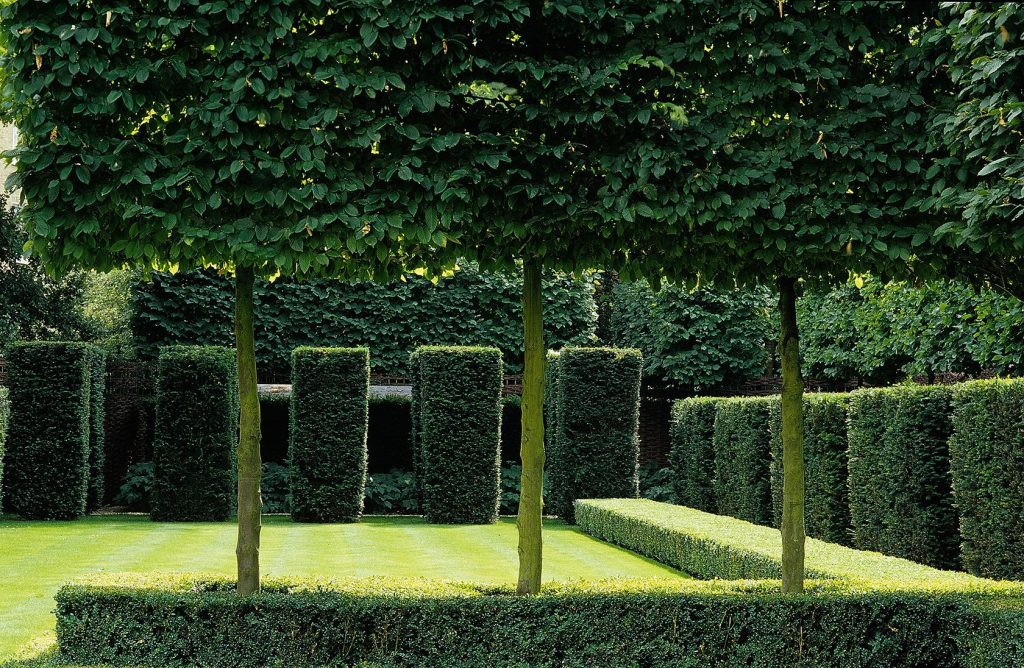The Hedge Factor
Hedges have existed since the first Bronze Age farmers who cleared woodland to create fields for farming. Certain strips of woodland were left around the edges to mark boundaries. Hedges were used creatively through the Tudor period to create a maze as seen at Hever Castle, the family home of Anne Boleyn and also the well-known Tudor knot gardens.
When my family moved to the UK in the early 1970’s, we had our first proper garden both back and front. It was a typical suburban semi with privet hedges between the houses and in late spring you could hear the clip clip clip of shears. These days we have more fences and walls. If given the choice, for me hedges always win. They are the unsung heroes of gardens, often getting forgotten compared to some fabulous scented roses or the flamboyance of a fascinator style dahlia. Sadly, the loss of hedgerows in the UK has resulted in the decline of many plant and animal species traditionally found around farmland.
Hedges produce oxygen, capture harmful pollution and help with noise reduction. This makes them far more important in dense urban areas. Contrary to belief hedges are far better at capturing pollution than trees are. They also help to capture pollutants and pesticides entering our water courses.
In rural areas hedgerows help to prevent or alleviate the effects of flooding by increased filtration rates and slowing water flow.

Photo Credit: Hevercastle.co.uk
Hedges have been part of garden history since the Bronze Age. Here we see the well know Tudor Maze at Hever Castle, the family home of Henry VIII’s second wife Anne Boleyn.
I have recently moved into a new home and we have a thick high native hedge in the front garden that gives us privacy from the road. However, the most joyful part of having this hedge is the amount of bird song. There is a hidden choir in the hedge that sings all day long. I’m sure this must have positive effects to our senses and wellbeing. They are particularly lively during the winter when food is scare as they are after the berries within the native hedge. Hedges provide homes for our feathered friends and let’s not forget that that they are good for the garden. They will eat unwanted bugs there by helping to keep infestation down. Hedges will encourage wildlife into your garden. It is also worth remembering that it is illegal to cut hedges during the bird nesting and breeding period which starts from March, finishing at the end of July.
Hedges provide the bones and structure to a garden. This structure of a garden is particularly important through the winter months when many plants will go dormant, but hedges will still provide interest through the winter months. Imagine Levens Hall in Cumbria with no hedges. The gardens would look positively naked. What would happen to Luciano Giubbilei’s gardens with the very structured 3 tiers of hedges. They would be pretty much non-existent as his handwriting was built upon this style. Hedges have various roles to play. They can provide green boundaries between properties and also screens for privacy. They can be used to create separate rooms within a large garden, each room then being able to benefit from its own look. They also make a great backdrop to a colourful planting scheme. Low hedges can help to define neat lines for borders and parterres.

Credit: Hevercastle.co.uk
Hedges do not have to be dull and boring. Here at Hever Castle they have created a full set of chess pieces and an opposition set are created on the other side.
There is a vast choice of hedging available and your choice should reflect your property and the look of the garden that you want to create. If you want a very formal look Yew (Taxus baccata), Portuguese Cherry Laurel (Prunus lusitanica) and Hornbeam (Carpinus betulus) are perfect options.
Taxus baccata
Commonly known as English Yew. A slow growing plant that is often used in formal gardens as it can be kept very compact. Yew is evergreen with dark green needle like leaves. The female plant produces red berries. It can be positioned in any aspect and soil type, but it hates having wet roots. Good drainage is paramount. Can grow over 12 meters but can be maintained to a manageable height. It can also be shaped so if you want an interesting topiary or undulating hedge this is the right plant
Prunus lusitanica
An evergreen hedge with deep green leaves and reddish purple stems. It has a formal look but is softer in look than Taxus baccata. In early summer it will bear racemes of little white flowers which are scented followed by small dark purple fruit. It is not an overly fussy plant and can be planted in any aspect and any type of moist but well drained soil. Can grow over 12 meters tall but can easily be maintained at a manageable height.
Carpinus betulus
A deciduous hedge but it holds onto its leaves well into winter. The leaves are ribbed with a finely toothed edge, pointed at the tip. It has a lovely limey green colour. Hornbeam produces both male and female catkins. The leaves turn a golden yellow in autumn. It is the only hedging plant that tolerates wet feet.
The trend in gardens is becoming more informal. If you live in a rural area you may want to consider a mixed native hedge. These are perfect for wildlife too. Other options are Hawthorn (Crataegus monogyny), Loropetalum chinensis, Lonicera nitida or Griselinia littoralis
Crataegus monogyny
Hawthorn is a popular native deciduous hedging plant. It has an abundance of white scented flowers in May. It is fast growing and has dense growth making it perfect for wildlife. The leaves are mid green and lobed. In autumn it bears red berries known as haws providing food for birds. It is thorny which makes it a good hedge for security. Suitable for all sites other than dense shade or very wet soil. Can grow up to 8 meters tall but can be maintained to a manageable size.
Carpinus betulus
A deciduous hedge but it holds onto its leaves well into winter. The leaves are ribbed with a finely toothed edge, pointed at the tip. It has a lovely limey green colour. Hornbeam produces both male and female catkins. The leaves turn a golden yellow in autumn. It is the only hedging plant that tolerates wet feet.
The trend in gardens is becoming more informal. If you live in a rural area you may want to consider a mixed native hedge. These are perfect for wildlife too. Other options are Hawthorn (Crataegus monogyny), Loropetalum chinensis, Lonicera nitida or Griselinia littoralis
Crataegus monogyny
Hawthorn is a popular native deciduous hedging plant. It has an abundance of white scented flowers in May. It is fast growing and has dense growth making it perfect for wildlife. The leaves are mid green and lobed. In autumn it bears red berries known as haws providing food for birds. It is thorny which makes it a good hedge for security. Suitable for all sites other than dense shade or very wet soil. Can grow up to 8 meters tall but can be maintained to a manageable size.

MaxPlank-Innovation @MP_Innovation
Architect Tim Bushe has made a claim to fame sculpting this incredible hedge into elephants in Finsbury Park. He has since had commissions to sculpt and carve hedges for other people.
Loropetalum chinensis
Loropetalum makes a very pretty loose hedge. It has burgundy leaves and pinky red scented flowers from February to April. Prefers partial shade. Hardy in coastal and mild areas of the UK. Loropetalum requires fertile moist well drained soil conditions which are humus rich. Grows up to 2 meters tall. Requires minimal pruning. A light clip will encourage bushy growth.
Lonicera nitida
This makes a good dense evergreen hedge but if left unclipped it gives a much looser natural look. It also clips well. The leaves small, oval and mid green. Can grow to 3.5 meters tall. Requires fertile well drained soil.
Griselinia littoralis
This is a fast-growing hedge with broadly oval evergreen limey green leaves. It makes an excellent hedge for exposed sites and coastal conditions. It has naturally loose growth. Prefers a sunny position with moist but well drained soil. Can grow above 8 meters tall but can be maintained to a manageable height.
For low hedging Box (Buxus sempervirens) was the plant of choice as it is compact and clips well. However, with the issues of box blight and now the box tree moth, it has fallen out of favour. There are other options on the market. Try Ilex crenata, Euonymus japonicus ‘Jean Hughes’, Rosmarinus officinalis, Taxus baccata or Lonicera nitida.
When maintaining tall hedges, it is advisable to cut at a slight batter. This keeps the hedge broader at the bottom and slightly narrower at the top. This practice helps the sun and the rain to penetrate right down to the bottom of the hedge otherwise the hedge will end up dying at the bottom and will only have top growth.
Good time of year to plant hedges is from October to March, so long as the ground is not waterlogged or frozen. Rootball plants are available between end October and February. These cost less than the containerized plants. It is also the time of year when there is rainfall which helps to settle the plants into the ground. When planting a fresh new hedge make sure that it is well watered the first few growing seasons to get it established. Once established it is worth giving your hedge a feed once a year.

Credit: Ferrebeekeeper.wordpress.com & Rosemary Verey
Rosemary Verey created this Tudor knot garden. This is a perfect example of how hedges whether high or low, give the bones and structure to a garden. When many other plants are dormant in the garden this still provides interest and being touched by frost just adds to it’s beauty.
N.B – the information given in this blog are a guide and suggestions only. Please make sure that all plants are checked for suitability to your site.

Credit: Luciano Giubbilei
Luciano Giubbilei built is handwriting and his reputation on using hedging in a very contemporary way. Here he uses them as sentinels to create a screen but still leaves you wondering what is beyond. It is simple but very effective as the eye is drawn through the pleached trees towards the back of the garden.



